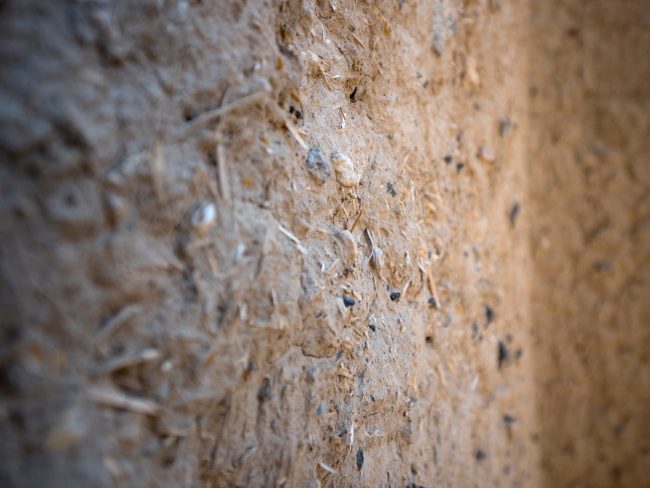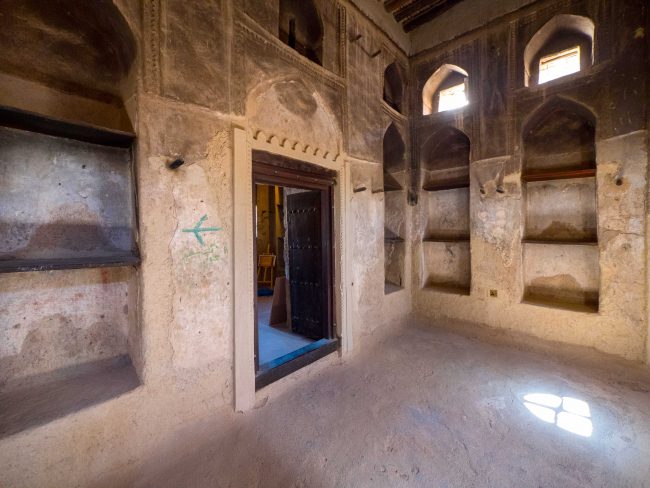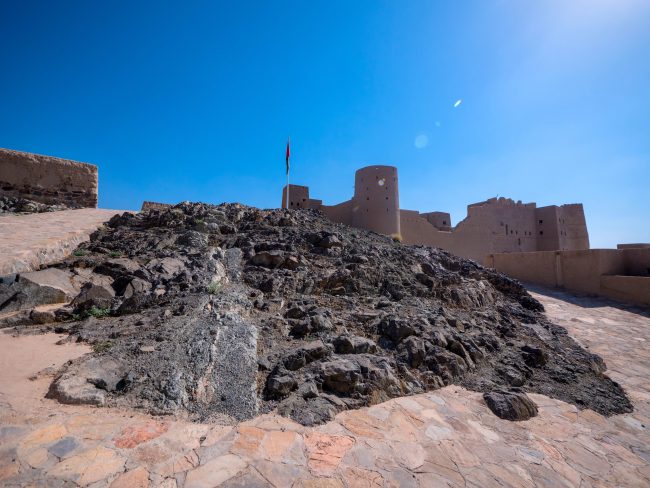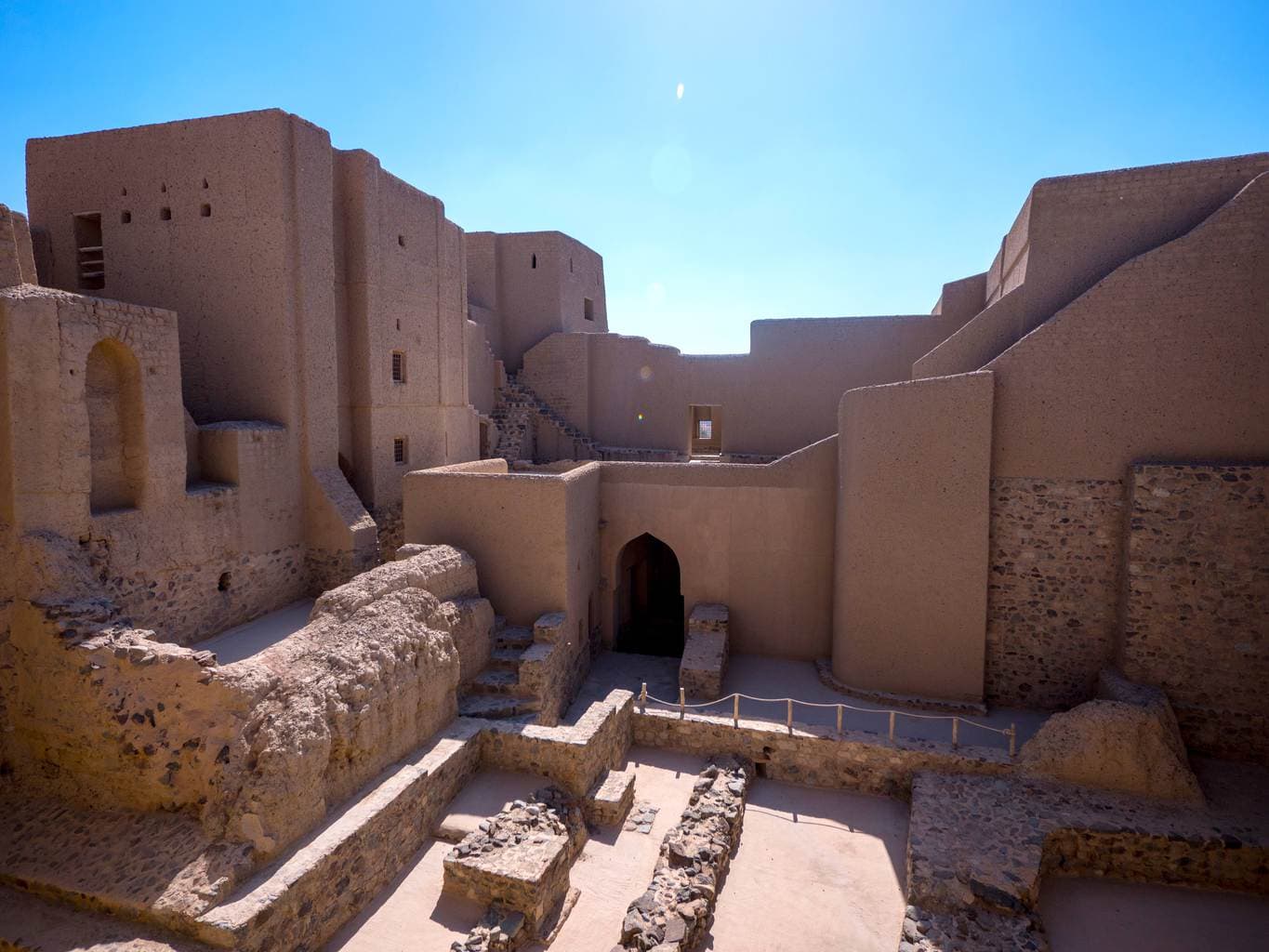
Bahla Fort is an Omani complex located at the base of the Jebel Akhdar mountains that was listed as Oman’s only UNESCO fort in 1987 and is one of only four UNESCO sites in Oman. The complex is an outstanding example of an Islamic, medieval era oasis settlement in sand color that blends into the arid landscapes of the surrounding mountains. Visiting Bahla Fort is stepping into a labyrinth of settlements, alcoves, rooms and defensive elements of pre-gunpowder Oman.
After over two decades of restoration, Bahla Fort finally soft-opened to the public in 2012 albeit without the audio guide of Jabrin Castle or the exhibits of Nizwa Fort. I have done extensive research on Bahla Fort for you so make sure to read this before visiting or use it as your guide to Bahla Fort.
Watch our video here:
History of Bahla Fort
Bahla Fort complex is made of three elements: the fort, a citadel oasis and an ancient city wall that spreads over 13 kilometres. The complex is believed to have been built by the Banu Nebhan tribe between the 12th and 15th centuries when they occupied this region of Oman and made Bahla their capital. It was subsequently expanded by the tribes that followed adding to the grandiosity of the fort.
The construction is made of mud and straw bricks cooked at very high temperatures and built contouring a rocky hill so the mountain’s rocks are often part of the constructions, the rooms, the floor or the walls of some of the spaces. It is incredible to think that the mud has survived so many centuries. UNESCO listed rain erosion as the most dangerous risk and classed the fort as “In Danger” until 2004 when the restoration work had managed to stop the effects of the rain with replacement of roofs, etc.
Below the fort there is an oasis which can be seen through the windows on the mountain side of the fortress and can be walked to. Even in the driest months of the year the oasis is always green with date palm trees and old mud houses dating from the time when the fort was in use thanks to the falaj irrigation system that is pervasive in that part of Oman.
The canals that channel the water to the crops manage the seasonal rains and the underwater sources to ensure that agricultural land is always well irrigated. Throughout the Jebel Akhdar mountains, the falaj can be spotted criss-crossing the plantations of date palm, pomegranate trees and roses, which are the typical crops in the area.
The fort is surrounded by tales of magic and is considered as “(…) the epicenter of Omani paranormal activity”.. Legends about the Bahla Fort abound.
In one, a woman is said to have built the Fort’s walls in one night alone. Other black magic tales talk about the restoration of the Fort being delayed because of the acts of “(…) an unseen force at night: stones erected and mortar plastered during the day would come unraveled in the night and be replaced by a ruin in the morning.
Perhaps an explanation can be found in the fact that 1400 years ago, a man was stoned to death by the villagers of Bahla for practicing wizardry” (source). The same legend also talks about a tree growing in the citadel that would bring an untimely death to anyone who touched it because the sorcerer had cast a spell on it. Reminds me of my time at Bhangarh Fort in India.
Our guide certainly believed them all, and he also believed that the fort had to have been constructed under such mystery and superhuman power because some elements of the fort were just impossible to have been built at the time without any machinery, like the deep and circular wells.
The Nebhani Dynasty
The Banu Nabhan is said to have built Bahla Fort along with other rulers of Oman from 1154 until 1624, when the Yaruba dynasty took power. Unlike Shia and Sunni, the Banu Nabhan tribe followed the moderate Ibadism branch of Islam, like many of the ancient Omani Imams and today’s modern Sultanate.
The Banu Nabhan were known across Arabia at the time because they controlled the trade in frankincense (a priced tree resin burnt as incense) from the Yabrin oasis through the Middle East and to the Mediterranean coast of modern day Iraq and Syria, ancient Mesopotamia. There are several other frankincense routes, but this was one of the most important. Frankincense continues to be a precious commodity today in Oman and beyond and one of the most valuable souvenirs you can buy in the Sultanate.
Exploring Bahla Fort – What to see
Bahla Fort is gigantic and a true maze of rooms and buildings with lots of spaces from six wells to several pairs of open air stairs, four round wind towers and many passages. There are also two mosques and two guest houses.
It is easy to get lost and wander for hours on end. We easily spent a couple of hours taking a look at pretty much every building although at a relatively fast pace. You can climb up the ladder to the wind towers and up the stairs to some of the attic rooms, provided you do not have fear of heights or too much common sense as there is no railing on the narrow and crumbling stairs. As there are practically no signs in any of the rooms, there is little information you can refer to, unlike Nizwa Fort which is impressive and filled with exhibits telling you about Omani life at that time.






When you enter the fort you first access the former place of prayer which has a small opening pointing at Mecca but otherwise has an altar to the Philistines. Our guide insisted that the Philistine altar was proof that the fort had been constructed around 500 AC. It is believed that the fort was first constructed by the Persians who inhabited the area, pre-Islamic times and that would explain the Hebrew altar.
There are three main areas in the fort: the Al-Qasabah, the oldest section of the fort, is a self-contained fortification located in the southeast corner. Bait al-Hadith, or new house, was built by the Ya’riba dynasty (1624-1743). Bait Al-Jabal (mountain house) was erected in the 18th century.
These are all incredibly labyrinthic and complete with many elements that were traditional of pre-gunpowder fortifications in the Oman of the time. For example, like Nizwa and other fortifications in the country, Bahla has many machicolations for pouring boiling water or date juice on attackers. The date room, on the ground floor, is incredibly large and resembles a Western wine cellar.
Other things to see near Bahla Fort and suggested itinerary
If you are making the journey to Bahla Fort you should make sure to visit some of the other places of interest around Nizwa like the Nizwa Fort, Jabreen Castle and Nizwa’s goat market and souk. You will not be able to visit it all on the same day if you go on Friday because they all close by 11am, but it is worth it to see the goat market.
Alternatively, you can skip the market and go on any other day of the week to see them all in a day’s trip from Muscat.
If you go on a Friday, I would suggest the following itinerary around Nizwa:
- Depart Muscat very early at around 6,30am, so you can be there by 8:30am.
- At 9,15am head to one of the three places as you will only have time to visit one:
- Nizwa Fort
- Jabreen Castle
- UNESCO-listed Bahla Fort
- At 11am go back to the market area and visit the souk area around it, including the date market, the pottery stalls and the labyrinthic alleys of the spice market.
- Have lunch in the area and drive back to Muscat.
You would have to go back for the rest of the sites on another day.
If you go on any other day of the week, this is what I would suggest:
- Depart Muscat early at around 7am, so you can be at Nizwa Fort by 9am. Visit this stunning fortification and all its exhibits which are very enlightening and filled with learning about that time in Oman.
- At 10:30am head to Jabreen Castle and explore the beautiful castle.
- At 12noon head for lunch at a nearby restaurant. Your driver will be able to suggest a place and if you are driving yourself, I suggest Ayadina Restaurant. We ate there and their traditional slow-cooked Omani rice and meat dishes are great, they are known for goat but if you do not fancy the fatty meat, the chicken was also great. There are also plenty of international options if you prefer including Indian dishes, pizza and all sorts of other dishes. You can park the car right in front.
- After lunch, at around 2pm, head to Bahla Fort, Oman’s only UNESCO-listed fort.
- The fort closes at 4pm when you can either head back to Muscat or make a final stop at Misfat Al Abriyyin, a quaint small town that feels like an oasis in the desert.
Book your tour here.
Getting to Bahla Fort

The fort can be reached by car on a 2h drive from Muscat on good roads. You are best to take a guide with you but it will be hard to find anyone who knows the fort well as there is very little information available about it, online or otherwise. We had a guide that was appointed by the Alila Jabal Akhdar but he had very limited knowledge of the place. He did his best to share bits and pieces of knowledge but it is a shame that so little information is available. He indicated that the government has been trying to get a contractor to create the same exhibits that can be found in Nizwa Fort but they have not managed to.
Beware that the Fort closes at 4pm every day and at 11am on Friday.
For recommendations on where to stay in Oman and the best luxury hotels in Oman check out this link.
Pin this to your #UNESCO pinterest board

- Check if you need a visa, get help processing it at iVisa.
- Never ever leave without travel insurance. Get affordable coverage from World Nomads or long term insurance from Safety Wing.
- I find all of my flights on KAYAK. Check their Deals section too.
- Search for all your transportation between destinations on the trusted travel booking platform Bookaway.
- I book all my day trips and tours via GetYourGuide, they are the best and their tours are refundable up to 24h in advance.
- Get USD35 off your first booking with Airbnb.
- Compare hotels EVERYWHERE at HotelsCombined and book with Booking.com.
- Compare car rental prices at Rentalcars.com





